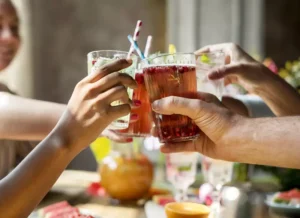
The term “relapse rate” refers to the percentage of individuals who return to drinking alcohol after a period of abstinence. Relapse what is the relapse rate for alcoholics is a common part of the recovery process, indicating that alcohol addiction and alcohol use disorder are chronic diseases that require ongoing management. Understanding alcohol relapse statistics, including the relapse rate after alcohol rehab, is essential for developing effective treatment plans and relapse prevention strategies. Preventing alcohol relapse is a fundamental aspect of the recovery process, with various strategies available for individuals to utilize in achieving this goal. Many studies have shown relapse rates of approximately 50% within the first 12 weeks after completion of intensive inpatient programs that often last 4 to 12 weeks or more and can cost tens of thousands of dollars.
- Relapse is often viewed as a common setback in recovery, much like flare-ups in other chronic diseases.
- In fact, approximately 75% of individuals with alcohol dependence relapse within the first year of treatment.
- Clients are taught to reframe their perception of lapses, to view them not as failures but as key learning opportunities resulting from an interaction between various relapse determinants, both of which can be modified in the future.
- Contact Infinite Recovery and start your journey toward a healthier, happier life free from addiction.
- Quite frankly, studies that have attempted to look at lapse and relapse rates across different substances have discrepant findings because the terms are often defined differently.
- Approximately 40% of individuals in recovery credit social support as a critical factor for their success.
How can I prevent alcohol relapse in my recovery journey?

The good news is that with the right treatment and support, individuals can overcome what is alcoholism their addiction and live a healthy and fulfilling life. An estimated 85% of people with alcohol or drug-related addiction issues relapse within a year after starting treatment. 40–80% of patients undergoing treatment for alcohol use disorders experience a “lapse” within the first year post-treatment.
Behavioral Therapies and Support Programs

For those on the path to recovery, alcohol relapse can pose a significant challenge, potentially derailing progress and causing further harm. With this https://ecosoberhouse.com/ in mind, understanding the factors that contribute to relapse and how to prevent it is crucial. Support systems do not only provide a community but also help individuals develop essential coping strategies to manage stressors effectively. This points to the broader importance of community and social support in preventing relapse, with those who cite such networks as essential to their recovery success reporting significant improvements in their sobriety journey. He statistics on alcohol relapse provide a sobering reminder of the challenges of achieving and maintaining sobriety.
What Are the Most Successful Alcohol Rehab Programs?

Specifically, RP was most effective when applied to alcohol or polysubstance use disorders, combined with the adjunctive use of medication, and when evaluated immediately following treatment. Moderation analyses suggested that RP was consistently efficacious across treatment modalities (individual vs. group) and settings (inpatient vs. outpatient)22. Marlatt, based on clinical data, describes categories of relapse determinants which help in developing a detailed taxonomy of high-risk situations. These components include both interpersonal influences by other individuals or social networks, and intrapersonal factors in which the person’s response is physical or psychological.
Substance Abuse and Domestic Violence: National Statistics
- The United States Preventive Services Task Force recommends screening adults for unhealthy alcohol use in the primary care setting.
- Monitoring drinking patterns and maintaining a strong support network are vital for long-term recovery.
- Relapse rates for alcohol use disorder exhibit notable differences based on gender and age, which can significantly impact treatment approaches.
- Family members provide encouragement and accountability, which can be instrumental during difficult times.
- With effective strategies in place, individuals can learn to manage their mental health symptoms while working towards sobriety.
A study published by Hunt and colleagues demonstrated that nicotine, heroin, and alcohol produced highly similar rates of relapse over a one-year period, in the range of 80-95%2. Relapse prevention (RP) is a strategy for reducing the likelihood and severity of relapse following the cessation or reduction of problematic behaviours4. However, various treatment options, including outpatient counseling and inpatient rehabilitation, are available to support individuals in their recovery journey. Remain mindful that relapse prevention is a continuous process, necessitating unwavering effort and alertness. By regularly evaluating and adjusting their relapse prevention strategies, individuals can stay one step ahead of potential triggers and challenges, ensuring their long-term success in maintaining sobriety. Recognizing these triggers and warning signs is vital for recovering individuals, facilitating the development of strategies to manage and evade potential relapses.
- Drug rehabilitation success rates depend on many factors and can be measured in a variety of ways.
- Behavioral therapies help recovering alcoholics understand their cravings, recognize triggers, and develop skills to make better decisions.
- Another possible outcome of a lapse is that the client may manage to abstain and thus continue to go forward in the path of positive change, “prolapse”4.
- Most people assume that an alcohol relapse starts the minute someone starts drinking again.
Paying for Treatment

Of the 95 participants, 69% relapsed following treatment, which is generally consistent with previous research on relapse rates in AUD (Durazzo and Meyerhoff, 2017; Kirshenbaum et al., 2009; Maisto et al., 2006a; Maisto et al., 2006b). In Australia, recovery rates for alcohol addiction vary depending on the treatment approach. According to a study, about 50% of individuals who receive treatment for alcohol addiction maintain abstinence or controlled drinking after one year. Reevaluating and adjusting the recovery plan is an ongoing process, requiring consistent effort and vigilance. By regularly re-evaluating and adjusting their relapse prevention strategies, individuals can stay one step ahead of potential triggers and challenges, ensuring their long-term success in maintaining sobriety. These statistics indicate that the likelihood of relapse decreases as sobriety is sustained following the initial recovery period.
